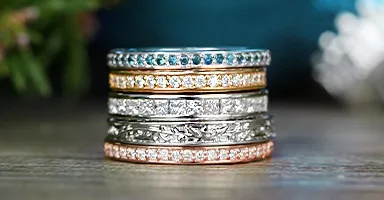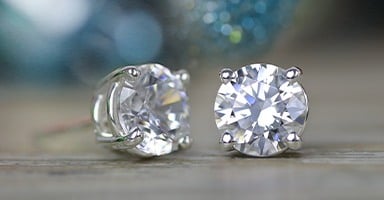How Much Does A Diamond Cost?

There’s nothing more special and timeless than a diamond, but owning one of these precious gemstones comes at a price. How much does a diamond cost? The average price can range from $1,500 for a 0.5-carat diamond to $21,000 for a two-carat diamond.
The truth is that answering this question is not easy because the price of a diamond can vary depending on a number of factors, including Clarity, Color, Cut, Carat, Shape and Fluorescence.

#1 Clarity
It’s common for diamonds to contain internal and external flaws, which are known as inclusions and blemishes, respectively. A diamond’s clarity grade is an evaluation of the number and location of these internal and external flaws. The Gemological Institute of America (GIA) assigns a clarity grade to each diamond using this scale:
- Flawless: No inclusions or blemishes are visible under 10x magnification.
- Internally Flawless: No inclusions, but some blemishes are visible under 10x magnification.
- Very, Very Slightly Included: Inclusions are present, but difficult to see under 10x magnification.
- Very Slightly Included: Minor inclusions are present and may or may not be easy to see under 10x magnification.
- Slightly Included: Inclusions are present and visible under 10x magnification.
- Included: Inclusions are obvious under 10x magnification and can impact the diamond’s appearance.
The difference from grade-to-grade may not be visibly noticeable to the untrained eye, but its clarity grade can still affect its price. Diamonds that are higher on the clarity scale are typically worth more than diamonds that are lower on the scale. Flawless diamonds are the most valuable, but they are incredibly rare.

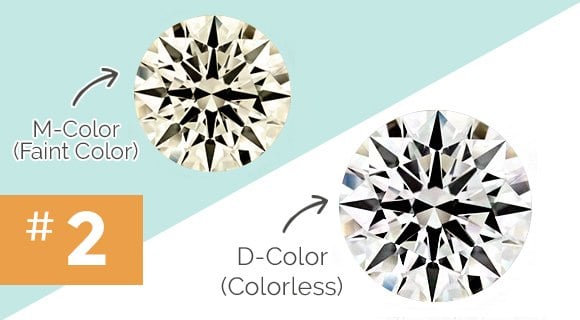
#2 Color
The color of the diamond can impact the price as well. A diamond’s color is graded on a scale that ranges from D to Z, where:
- D, E, F: Colorless
- G, H, I, J: Near Colorless
- K, L, M: Faint Color
- N, O, P, Q, R: Very Light Color
- S, T, U, V, W, X, Y, Z: Light Color
The lower the diamond falls on the color scale, the lower its value. A diamond with a ‘G’ color grade would typically be less value than a diamond with an ‘E’ grade, for instance. This is because colorless diamonds are far more rare than diamonds with a yellow or brown tint, which makes them far more valuable as well.

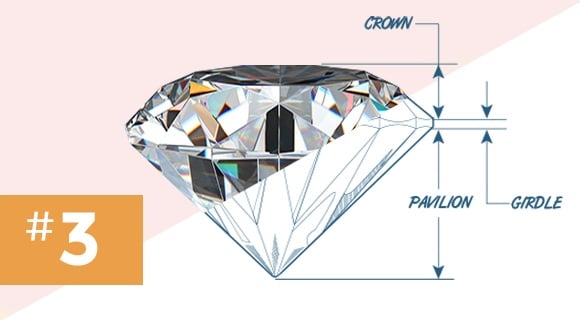
#3 Cut
People often refer to the diamond’s shape as its cut, but the two terms should not be used interchangeably. The cut determines how the diamond will sparkle and shine, whereas the shape simply describes its form. The GIA only assigns cut grades to round brilliant diamonds, however, retailers may have their own grading system to assess the cut of other diamond shapes.
The diamond’s cut grade evaluates:
- Brilliance
- Fire
- Scintillation
- Weight ratio
- Symmetry
The cut can have a significant impact on the price of the diamond. Diamonds with excellent cuts are more valuable and thus more expensive.

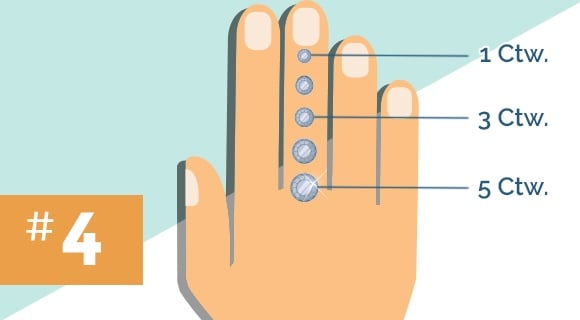
#4 Carat
A carat is a unit of measurement that is used to express a diamond’s weight. One carat is equal to 0.20 grams or 0.007 ounces.
Larger diamonds are more rare, so diamonds typically increase in price as they increase in carat.
The increase in the cost of the diamond is not always proportionate to the increase in its size. A two-carat diamond will not necessarily cost twice as much as a one-carat diamond, for example. This is because carat is one of many qualities that affects a diamond’s price, so other factors must be considered when calculating a diamond’s value.

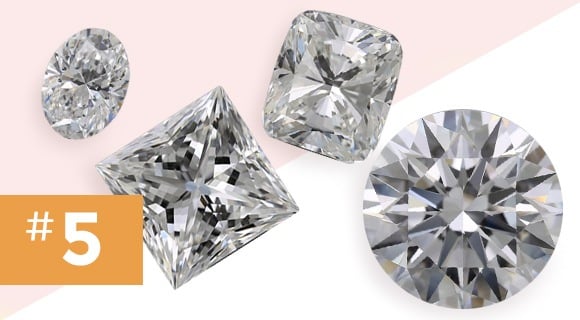
#5 Shape
Another factor that affects the cost of a diamond is its shape. Although prices according to shapes may vary, there is a consensus that the round shape is the most expensive. Some shapes include Round, Princess, Oval, Radiant, Marquise, Pear, Heart, Cushion, Emerald and Asscher.
Why does the shape of the diamond affect its price? Diamond cutters lose some of the original stone when cutting diamonds, and the amount that goes to waste will vary depending on the shape.
A lot of the original diamond is wasted when cutting a round diamond, for example, which is why this shape typically has a higher per-carat price. Less is wasted when cutting other diamond shapes, making them more affordable.

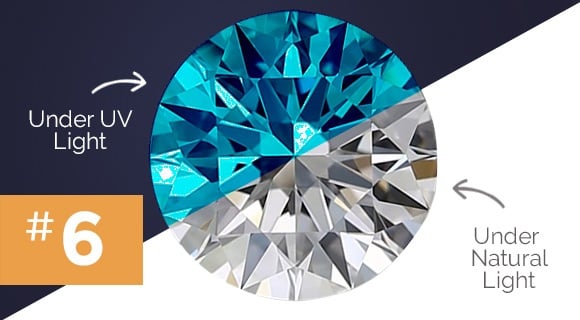
#6 Fluorescence
About 30% of diamonds have a fluorescent effect, which means they emit a soft glow when placed under ultraviolet (UV) light.
Fluorescence can have either a positive or negative effect on the diamond’s price. The bluish glow can cancel out the yellowish-brown hue of a diamond with a low color grade, making it appear colorless. For this reason, the fluorescent effect can increase the value of these diamonds.
Fluorescence can create a somewhat cloudy or oily appearance in diamonds that are colorless or near colorless. This can make the diamond look less desirable, thus lowering the value and cost of the gemstone.

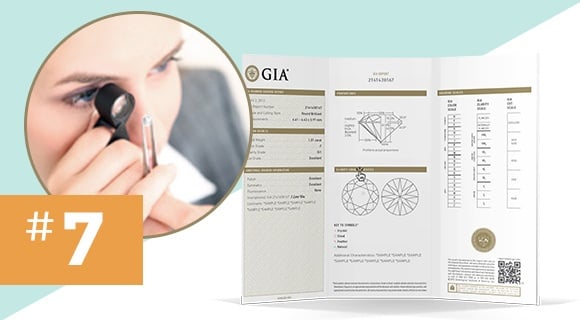
#7 The GIA Diamond Grading Report
Retailers will provide information on the diamond’s cut, color, clarity, carat, shape, and fluorescence. It’s in your best interest to verify a diamond’s information by looking at the GIA Diamond Grading Report.
This report breaks down this information in a way that is easy to read and understand. This report contains information on Carat Weight, Color Grade, Clarity Grade, Cut Grade (round diamonds only), Symmetry, Fluorescence, Proportions, Location of Inclusions and Blemishes and Inscriptions (if applicable).
It’s important to thoroughly review this report so you can verify the stone’s value before purchasing it. Brilliance offers this report for all loose diamonds sold.

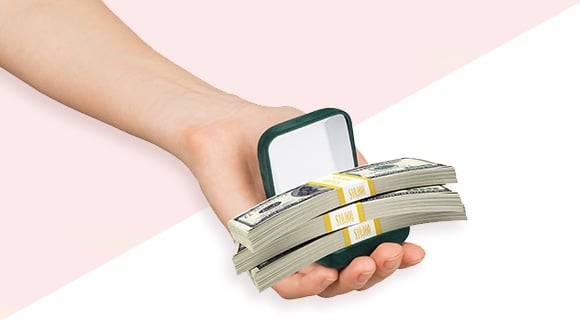
The Art of Calculating the Cost of A Diamond
How much does a diamond cost? There’s no simple answer to this question because there are so many factors that must be considered when calculating the cost of a diamond.
The loose diamonds on the Brilliance site range from as little as $125 for a 0.17-carat princess cut diamond to as much as $6,423,850 for a 50-carat round cut diamond. Use the filters on this diamond search tool to quickly find diamonds within your budget!



